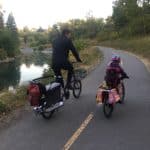I spent the last couple of evenings getting my feet wet in our local bike activism community, first by attending my first Bike Calgary infrastructure group and then board meeting, followed by a talk on gender and cycling at the Women’s Centre the next night. If there is one thing that I gleaned from it all is that cyclists still only represent 1.8% of mode share in Calgary but that as we implement more infrastructure, that number grows. And, I was taught how to have my voice heard as best possible in order to help get the infrastructure we need.
There are several reasons why I want my voice heard and two of the key reasons are: women and children. I want to see an equal number of women and men riding bikes in Calgary — right now it hovers around 30%-ish women — and I want street design to be kid-proof so that we can groom the next generation to be independent and make healthy choices.
Here is what you can do to have your voice heard, too:
Letters
Kick it old school and bust out the proverbial pen and paper. Actually, head to your computer (at home or the library) and find a template for a formal letter, write it, then post it in the mail with an envelope, stamp — the works.
Who you want to be writing to:
- your community association
- your ward councillor
- your local BIA/BRZ
There is a saying out there that one letter represents at least ten other voices (who aren’t writing letters). Letters can be powerful.
Community association
Each community in Calgary has a community association (CA). Some communities are lumped together. Most CAs have a transportation representative on their board. Councillors (or their representatives) are in communication with the transportation rep of the CAs that are in their wards, collecting information on local issues. This is a great starting point to effect change in your immediate community, like traffic calming.
You could accomplish this by letter or in person at your CA meeting, which should be happening monthly. Often a rep from the councillor’s office is at these meetings.
Ward councillor
Your councillor was elected by a majority of the people who chose to vote in your ward. Their job is to represent their constituents in the municipal democratic process. Write them a good old fashioned letter including the following:
- describe the issue as simply as possible (your letter’s thesis statement, if you will);
- provide some background information of the issue to put it in context;
- explain what you are asking for, including clear steps on how to get there (avoid getting upset; keep it clear and concise; maintain a positive tone); and,
- briefly conclude by letting them know that you are their constituent and, if possible, commend them on something they have done or voted for that you also support.
Use plain language and avoid being combative. Consider bringing up other layers of the issue and not just the one that concerns you, helping to support your points. For example, traffic calming measures help cyclists but also pedestrians and local residents, preventing cars from zipping down residential streets or turning sharply at corners, especially in areas facing increased density over time — better to be proactive and implement traffic calming measures now then down the road when there are even more parties concerned in an issue. Consider outlining steps for a Plan B, a compromise that you could live with if your main desire has already faced pushback; Plan B is a great time to really sell those other layers of the issue.
Local BIA/BRZ
Local shopping areas in town have a group that represents business owners in the area. Many of these busy shopping streets have been designated as official main streets under the City’s Main Streets program and are in various stages of the design process to make them more livable spaces, destinations, and functional hubs for people. Money talks and I would argue that the BIA/BRZs have a big role in influencing planning decisions on their main streets, so these organizations need to hear that you would spend more money on their streets if there was better bike infrastructure available to you: traffic calming on parallel streets and/or protected cycle tracks on the main street, itself; and, safe bike parking in front of their spaces, for example.
Public engagement events
The City of Calgary holds many public engagement events. Some are information sessions and some are full on engagement and idea generating workshops, depending on what point in the cycle a project is at. They often present several ideas that they have and workshop them in small groups or similar, with the opportunity to chat with City employees or consultants.
Unfortunately, these sessions can digress into opportunities for citizens to vent about other off-topic issues in their neighbourhood and seem to be overly represented by retired NIMBY-types in many communities. These are not the people advocating for cycling. These people are advocating for ease of driving and parking, parking, parking. Which is too bad, as they’ll likely be deceased or no longer able to drive by the time many bigger picture projects are implemented.
It would be cool if the City weighted the input from public engagement based on demographics, i.e. not giving in to the generation of drivists who physically show up to events but weighting those citizens’ views as a proportion of the demographic for the neighbourhood, or something along those lines.
Public engagement online
In 2016, the City of Calgary launched their online “Engage” portal: https://engage.calgary.ca. Which is great, I like online stuff. I’m busy and have attended a few public events but they often coincide with tired kids, dinnertime, bedtime, or precious family time on weekends. Blech. Not ideal. The internet I can handle. Fine, it might not be very community-oriented and can be impersonal, but it gives me the chance to have my ideas represented without having to work with someone else’s schedule.
The downside to this portal is that there is a big push to have an online component for everything the City is seeking feedback on or engagement with, or so I was told at an event recently by a city employee; as such, there are quite a few projects available for feedback online so it might be hard to find the ones of interest to you or cycling-related ones. You also have to be personally engaged in social media (or be checking back frequently) to know when new surveys are live and relevant for you. That said, it seems fairly well organized — I found it easy to find the freshly live link to the Calgary and Area Bikeway and Pathway Plan engagement [BTW, it’s live through Friday, June 8, 2018, so fill it out!]. Be aware of surveys that do not have the option for you to add on any other concerns related to the issue, like the bikeway and pathway plan does not address the difference between people’s likelihood to choose a route type in winter (i.e. I may choose a busier road in dry conditions but I would steer clear from it in snowy/slippery conditions and there is no where in the survey for me to indicate that huge difference) — surveys are persnickety and very hard to create effectively. This is where showing up in person has a huge advantage.
311
The City of Calgary has a 311 telephone line, a 311 smartphone app, and a 311 website where you can file a request… or a compliment! 311 was implemented in 2005 and they have handled millions of calls since then. I have had some requests handled immediately and others <crickets>. I think it’s worth a shot, though. Positive experiences include getting a bike rack installed at the Stanley Park Outdoor Pool and snow removal on certain sidewalks or pathways that get missed on occasion. If you choose to contact a councillor through their online form, you will likely be asked for a file number from your 311 request, i.e. it’s a good idea to file a 311 request and save the number prior to contacting a councillor with respect to a certain issue.
Note that if/when your request is ‘closed’ that doesn’t necessarily mean it has been dealt with by the appropriate department, it just means that the 311 folks have passed it off to the appropriate people and that the 311 people are done their bit in the process (as per the 311 FAQ).
Social media
Calgary has a very active bike community online, notably on Twitter under the #yycbike hashtag. And, most councillors have an active Twitter presence and some are quite engaged with citizens on this platform. That said, it does not seem to have much affect with respect to effecting change. Old fashioned letters are where it’s at when it comes to communication of opinions and ideas. Twitter can be a bit of a vacuum.
However, Twitter is wonderful for community building and idea generating. Just make sure to take pen to paper if you are feeling truly passionate about an idea or want to formalize your position with your elected representative! Apparently emails are okay, but paper is best.
Local advocacy groups
Check in with local advocacy groups, primarily Bike Calgary, and see what they’re up to. They might have a survey or project of interest that they’re advocating for and you could help out.
What else would you add to this laundry list of ways to have your #yycbike voice heard in Calgary?








It is a great service to provide this info. I worked in “transportation” in the public arena for most of my career – in the US, Canada and Europe, and learned early that understanding the government and community program/process – and getting involved can be very important. So many do not know where to start, and it is great you provided this outline. For those outside you area, I will add that the process outlined here is similar to what they will find in their local area, and can be used as a roadmap to ask questions and learn about your own community.
Thanks! And, great to know — I’m glad that there is some similarity across the board. It’s been enlightening to learn about the process as I don’t know how much time I have to physically commit to attending various organizations meetings, etc, but I am confident that I can take the time to write some letters and contact the appropriate people within my community. It’s empowering.